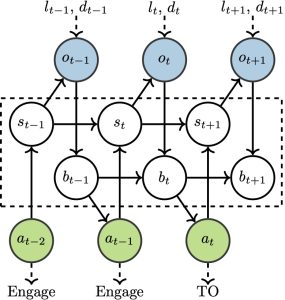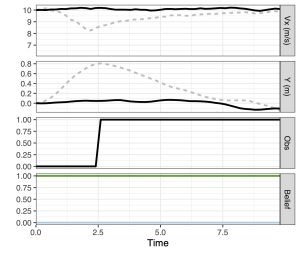Active inference models of driver behavior
In this project, we are using the theory of active inference and the free energy principle to develop models of driver behavior and interactions with automation


Lab Members:
Ran Wei
Collaborators:
Dr. Gustav Markkula
Dr. Johan Engström
Dr. Alfredo Garcia
Dr. Ranjana Mehta
Sponsors:
National Science Foundation
Waymo
US Department of Transportation
Publications:
Engström, J., Wei, R., McDonald, A. D., Garcia, A., O’Kelly, M., & Johnson, L. (2024). Resolving uncertainty on the fly: modeling adaptive driving behavior as active inference. Frontiers in neurorobotics, 18, 1341750. [Link]
Wei, R., McDonald, A. D., Garcia, A., & Mehta, R. K. (2023, September). Is trust a belief, observation, or state: Results from an active inference analysis of driver-automation transitions of control. In Proceedings of the Human Factors and Ergonomics Society Annual Meeting (Vol. 67, No. 1, pp. 1152-1153). Sage CA: Los Angeles, CA: SAGE Publications. [Link]
Wei, R., McDonald, A. D., Garcia, A., & Alambeigi, H. (2022). Modeling driver responses to automation failures with active inference. IEEE transactions on intelligent transportation systems, 23(10), 18064-18075. [Link]
Naturalistic driving studies and healthcare
Driving is a crucial activity for daily living and a health benchmark for individuals with acute and chronic illness. In this series of projects, we are exploring naturalistic driving and qualitative methods to understand driving transitions and develop tools to improve driving safety.
Lab Members:
Rika Luong
Kiara Tseten
Collaborators:
Dr. Valerie Danesh
Baylor Scott and White Research Institute
Vanderbilt University
Sponsors:
National Institutes of Health National Institute for Aging
Publications:
Potter KMDanesh VButcher BWEaton TLMcDonald ADGirard TD. Return to Driving After Critical Illness. JAMA Intern Med. 2023;183(5):493–495. doi:10.1001/jamainternmed.2022.7096 [Link]
McDonald AD, Danesh V, Ray JM, Stevens AB. Analysis of Silver Alert Reporting System Activations for Missing Adults With Dementia in Texas, 2017 to 2022. JAMA Netw Open. 2023;6(2):e2255830. doi:10.1001/jamanetworkopen.2022.55830 [Link]
Danesh, V., McDonald, A. D., McPeake, J., Eaton, T. L., Potter, K., Su, H., … & Boehm, L. M. (2023). Driving decisions after critical illness: qualitative analysis of patient-provider reviews during ICU recovery clinic assessments. International Journal of Nursing Studies, 146, 104560. [Link]
Pathways to remote operation for automated trucking
Automation will play a crucial role in the future of Trucking, however, remote operators will likely be needed to help maintain efficiency and safety. In this project we are exploring methods and designs to optimize remote driving for human operators including managing latency, modeling control of multiple trucks, and integrating novel control algorithms.
Lab Members:
Mateo Ma
Collaborators:
UW-Madison TOPS Lab
UW-Madison SBEL Lab
Sponsors:
National Science Foundation
Publications:
Past Projects
Modeling driver behavior during platooning failuresIn this project we developed a model of human behavior during automation failures that may be integrated into current and future design processes for automated vehicles. We will use this model to generate a set of design guidelines for future automated vehicle following technologies that will promote safety and reduce automated driving crashes. Lab Members: Hananeh Alambeigi Collaborators: Sponsors: Safety through Disruption (Safe-D) Publications: McDonald, A. D., Alambeigi, H., Engström, J., Markkula, G., Vogelpohl, T., Dunne, J., & Yuma, N. (2019). Toward computational simulations of behavior during automated driving takeovers: a review of the empirical and modeling literatures. Human factors, 61(4), 642-688. Alambeigi, H., McDonald, A. D. (2020). Modeling Post-takeover Avoidance and Stabilization Steering Control in Automated Vehicles. In Proceedings of the Human Factors and Ergonomics Society Annual Meeting (Vol. 64). Sage CA: Los Angeles, CA: SAGE Publications. Alambeigi, H., McDonald, A. D., & Tankasala, S. R. (2020). Crash Themes in Automated Vehicles: A Topic Modeling Analysis of the California Department of Motor Vehicles Automated Vehicle Crash Database. In Proceedings of the 99th Transportation Research Board Annual Meeting. |
Reducing drowsy driving in night-shift workersIn this project, we employed a user-centered design approach to develop an educational and technological intervention program to prevent drowsy driving crashes among shift-workers. Lab Members: Alec Smith Collaborators: Sponsors: Road to Zero Safe Systems Innovation Grant, National Safety Council (NSC) Publications: Smith, A., Sasangohar, F., McDonald, A. (2019). Mitigating Drowsy Driving in Night Shift Nurses Using a Technological Device. In Proceedings of the Human Factors and Ergonomics Society Annual Meeting. Santa Monica, CA: Human Factors and Ergonomics Society. Smith, A., McDonald, A., Sasangohar, F. (2020). Preventing drowsy driving crashes among night shift nurses: An evaluation of education and technological interventions. In Proceedings of the Human Factors and Ergonomics Society Annual Meeting. Santa Monica, CA: Human Factors and Ergonomics Society. Smith, A., McDonald, A.D., Sasangohar, F. (2020). Night-shift nurses and drowsy driving: A qualitative study. International Journal of Nursing Studies. Zahed, K., Smith, A., Sasangohar, F., McDonald, A. (2020). Investigating the effect of education and drowsiness detection on nurses’ beliefs and attitudes towards drowsy driving. In Proceedings of the Human Factors and Ergonomics Society Annual Meeting. Santa Monica, CA: Human Factors and Ergonomics Society. |
Social Media Analyses of Autonomous Vehicle CrashesIn this project we used Twitter tweets and replies to understand driver responses to automted vehicle crashes then used that information to develop a set of guidelines for social media reporting. Lab Members: Jaycelyn Jefferson, Hananeh Alambeigi, Ran Wei Sponsors: Safety through Disruption (Safe-D) Publications: Jefferson, J., & McDonald, A. D. (2019, November). The autonomous vehicle social network: Analyzing tweets after a recent Tesla autopilot crash. In Proceedings of the Human Factors and Ergonomics Society Annual Meeting (Vol. 63, No. 1, pp. 2071-2075). Sage CA: Los Angeles, CA: SAGE Publications. Wei, R., Alambeigi, H., McDonald, A. D. (2020). Crash Tags: Topic Modeling Social Media Data After Fatal Automated Vehicle Crashes. In Proceedings of the Human Factors and Ergonomics Society Annual Meeting (Vol. 64). Sage CA: Los Angeles, CA: SAGE Publications. |
Inverse Reinforcement Learning to Detect Mental FatigueMental fatigue presents a challenge for reinforcement learning and inverse reinforcement learning models of human behavior that rely on demonstrations and assume those demonstrations arise from alert humans. In this project, we focused on developing new algorithms to learn in the presence of fatigue. Lab Members: Ran Wei Collaborators Sponsors: Army Research Office |
Using Machine Learning to Improve Mental HealthThis research aimed to develop a data-driven PTSD self-care system for off-the-shelf wearable devices for veterans who have PTSD.
Lab Members: Mahnoosh Sadeghi Collaborators: Publications: Smith, A., McDonald, A.D., Sasangohar, F. (2020). Night-shift nurses and drowsy driving: A qualitative study. International Journal of Nursing Studies. Zahed, K., Smith, A., Sasangohar, F., McDonald, A. (2020). Investigating the effect of education and drowsiness detection on nurses’ beliefs and attitudes towards drowsy driving. In Proceedings of the Human Factors and Ergonomics Society Annual Meeting. Santa Monica, CA: Human Factors and Ergonomics Society. Sadeghi, M., Sasangohar, F., McDonald, A., & Hegde, Sudeep (2020). Understanding Heart Rate Reactions to Post Traumatic Stress Disorder (PTSD) Among Veterans. In Proceedings of the Human Factors and Ergonomics Society Annual Meeting (Vol. 64). Sage CA: Los Angeles, CA: SAGE Publications. Sadeghi, M., Sasangohar, F., & McDonald, A. (2019). Analyzing Heart Rate as a Physiological Indicator of Post-Traumatic Stress Disorder: A Scoping Literature Review. In Proceedings of the Human Factors and Ergonomics Society Annual Meeting (Vol. 63, No. 1, pp. 1936-1936). Sage CA: Los Angeles, CA: SAGE Publications. |
Driver Attitudes and Emotions Bicyclist Safety Study (T3 Triads for Transformation)This research explored mechanisms of traffic crashes between drivers and bicyclists, particularly the role of emotional associations of drivers with bicyclists and how those associations effect visual search, inattentional blindness, and roadway interactions with bicyclists. Triads for transformationInformation on the T3 (Texas A&M Triads for Transformation program) can be found here. Lab Members: Hananeh Alambeigi Collaborators: Publications: Goddard, T., McDonald, A. D., Alambeigi, H., Kim, A. J., & Anderson, B. A. (2020). Unsafe bicyclist overtaking behavior in a simulated driving task: The role of implicit and explicit attitudes. Accident Analysis & Prevention, 144, 105595. |
Using Machine Learning to Detect Crash RisksLab Members: Daniel Ik-Obazee Sponsors: Safety through Disruption (Safe-D) |
Using Machine Learning to Design Procedures |
Vehicle-based drowsy driving detectionThis goal of this project is to use innovative data analysis and reduction techniques to design state of the art algorithms for detecting drowsy driving. The project specifically focuses on integrating driving context (i.e. types of roads, traffic, road condition) and various graphical modeling approaches (e.g. Hidden Markov Models, Hidden semi-Markov Models) to improve algorithm performance. |
Distracted driving detectionThe goal of this study is to design innovative algorithms that detect various types of driver distraction including cognitive, sensory-motor, and emotional distraction. |
Naturalistic driving and chronic health conditionsThis series of naturalistic driving studies focuses on analyzing how drivers’ behavior changes as they are impacted by chronic health conditions such as obstructive sleep apnea (OSA), diabetes, and age related decline. The goal of the project is to design algorithms to comb through large amounts of driving data and identify changes in driving behavior that may lead to safety hazards. After development and refinement the algorithms can be integrated into the health care process to reduce in patient visits and assess treatment options. |